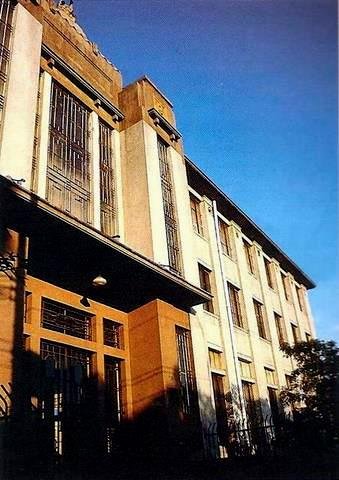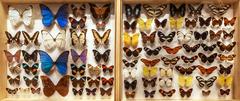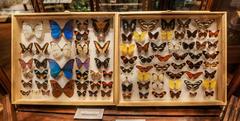
Visiting the Museum of Zoology of the University of São Paulo (MZUSP): Tickets, Hours, and Guide
Date: 14/06/2025
Introduction: A Gateway to Brazil’s Biodiversity
Situated in São Paulo’s historic Ipiranga district, the Museum of Zoology of the University of São Paulo (Museu de Zoologia da Universidade de São Paulo, MZUSP) is a cornerstone of Brazilian scientific research, education, and cultural heritage. Established in the late 19th century, MZUSP has grown into Latin America’s largest repository of Neotropical fauna, with approximately 13 million specimens spanning mammals, birds, reptiles, amphibians, fish, and invertebrates. The museum is internationally recognized for its commitment to the study, preservation, and public dissemination of Brazil’s natural wealth. This guide will provide all essential information for planning your visit, from historical context to ticketing, exhibitions, and practical tips, as well as suggestions for nearby attractions to enrich your São Paulo experience. For more, visit the official MZUSP website and explore resources like SciELO Brazil and Arquivos de Zoologia.
Contents
- History and Significance
- Visitor Information
- Location & Directions
- Hours & Admission
- Accessibility
- Guided Tours & Educational Programs
- What to Expect
- Nearby Attractions
- Collections and Research Highlights
- Visual & Interactive Resources
- Frequently Asked Questions (FAQ)
- Visitor Tips
- Conclusion
- References
1. History and Significance
Origins and Early Development
MZUSP’s roots trace back to the late 19th century, beginning with the Geological Commission of the Empire of Brazil (1875–1878), which laid the foundation for systematic zoological research in the country (MZUSP Coleoptera Collection). The Geographical and Geological Commission of São Paulo (CGG) further propelled this mission by establishing collections that would become the museum’s core.
By 1893, the CGG collections merged into the Museu do Estado, and in 1894, the Zoology section was formally created under the directorship of German naturalist Hermann von Ihering. The museum’s initial installation in Ipiranga foreshadowed its enduring association with the district (MZUSP Coleoptera Collection, SciELO Brazil).
Growth and Institutional Evolution
MZUSP expanded through significant donations and the acquisition of private collections, establishing a reputation for scientific excellence. Leadership by figures like Orville Adalbert Derby and Adolph Hempel helped internationalize its research, while the museum’s integration with the University of São Paulo in 1969 marked a new era of academic collaboration and growth.
Architectural and Scientific Milestones
Constructed in 1938–1939, the museum’s building is the only one in Brazil specifically designed to house zoological collections (SciELO Brazil). Today, MZUSP’s collections are among the world’s most comprehensive, with a critical role in conservation, education, and public outreach.
Commitment to Modernization
From 1992 onward, the museum has embraced digital cataloging and platforms like Specify, enhancing access for researchers and the public (MZUSP Coleoptera Collection). MZUSP also publishes the peer-reviewed journal “Arquivos de Zoologia,” furthering its impact in zoological sciences (Arquivos de Zoologia).
2. Visitor Information
Location & Directions
- Address: Avenida Nazaré, 481 – Ipiranga, São Paulo, SP, Brazil
- Access: Reachable by public transport (bus lines, Ipiranga Metro station) and by car. Parking is available nearby.
Hours & Admission
- Tuesday to Friday: 10:00 AM – 5:00 PM
- Saturday, Sunday, Holidays: 10:00 AM – 6:00 PM
- Closed: Mondays and select public holidays
- Admission: Free for all visitors (special exhibitions may have a separate fee; check official site).
Accessibility
- Wheelchair accessible with ramps, elevators, and assistance available upon request.
- Facilities include restrooms and accessible routes.
Guided Tours & Educational Programs
- Guided Tours: Available for groups and schools by prior booking via the MZUSP Visits page.
- Educational Programs: Workshops, lectures, and events run throughout the year, engaging diverse audiences.
What to Expect
- Explore permanent and temporary exhibitions illustrating Brazil’s vast animal diversity.
- Interactive displays, educational panels, and a well-equipped zoological library.
- Most text panels are in Portuguese, with English translations to support international visitors.
Nearby Attractions
- Museu do Ipiranga: A major Brazilian history museum.
- Parque da Independência: Historic park adjacent to the museum.
- São Paulo Botanical Garden: A short ride away and perfect for nature lovers.
3. Collections and Research Highlights
Zoological Collections
- Vertebrates:
- Mammals, birds, reptiles, amphibians, and fish from across Brazil and the Neotropics.
- Invertebrates:
- Insects (notably Coleoptera and Lepidoptera), crustaceans, arachnids, mollusks, myriapods, and Brazil’s largest myriapod collection.
- Paleontology:
- Fossils from Brazilian sedimentary basins, providing insight into ancient ecosystems.
Research and Facilities
- Advanced laboratories in chronobiology, electron microscopy, molecular biology, histology, and CT scanning.
- The Boracéia Biological Station in the Atlantic Forest, a hub for ecological and taxonomic studies.
4. Visual & Interactive Resources
- High-quality exhibits with detailed specimen displays.
- Virtual tours and multimedia content available on the museum’s website.
- Recommended visuals:
- The museum’s historic façade
- Amphibian and insect collections
- Interactive exhibition areas
5. Frequently Asked Questions (FAQ)
Q: What are the opening hours?
A: Tuesday to Friday, 10:00 AM – 5:00 PM; weekends and holidays, 10:00 AM – 6:00 PM; closed on Mondays.
Q: How much is admission?
A: Admission is free. Special exhibitions may require a separate ticket.
Q: Is the museum accessible?
A: Yes, the museum is fully wheelchair accessible.
Q: Are guided tours available?
A: Yes, by advance arrangement, especially for groups and schools.
Q: Can I take photos inside?
A: Photography for personal use is generally allowed, but flash and tripods are usually prohibited.
Q: Are there visitor facilities?
A: Yes, including restrooms and a gift shop. There is no on-site café, but options are available nearby.
6. Visitor Tips
- Best Time to Visit: Weekdays, especially mornings, are less crowded.
- Duration: Allocate 2–3 hours for a thorough visit.
- Travel: Use public transport for convenience; parking is limited.
- Group Visits: Book ahead for groups of 15+ via the MZUSP Visits page.
- Photography: Respect exhibition policies regarding flash and tripods.
- Explore Nearby: Combine your trip with visits to the Museu do Ipiranga and Parque da Independência.
7. Conclusion
The Museum of Zoology of the University of São Paulo (MZUSP) stands out as a world-class institution for anyone interested in zoology, natural history, and Brazil’s unique biodiversity. Combining scientific excellence, rich collections, and accessible educational programs, it offers a memorable and enriching experience for all visitors. Located in the lively Ipiranga district and offering free admission, MZUSP is an essential stop for students, families, researchers, and tourists alike. Plan your visit today to discover the wonders of Neotropical fauna and support ongoing scientific and conservation efforts (MZUSP Official Site, MZUSP Visits).
8. References
- MZUSP Coleoptera Collection
- SciELO Brazil
- Arquivos de Zoologia
- MZUSP Official Website
- MZUSP Visits Information





































































































































































